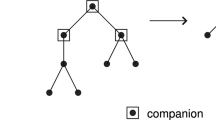Summary
Global relations between RNA sequences and secondary structures are understood as mappings from sequence space into shape space. These mappings are investigated by exhaustive folding of allGC andAU sequences with chain lengths up to 30. The computed structural data are evaluated through exhaustive enumeration and used as an exact reference for testing analytical results derived from mathematical models and sampling based on statistical methods. Several new concepts of RNA sequence to secondary structure mappings are investigated, among them that ofneutral networks (being sets of sequences folding into the same structure). Exhaustive enumeration allows to test several previously suggested relations: the number of (minimum free energy) secondary structures as a function of the chain length as well as the frequency distribution of structures at constant chain length (commonly resulting in generalized forms ofZipf's law).
Zusammenfassung
Die globalen Benziehungen zwischen RNA-Sequenzen und Sekundärstrukturen werden als Abbildungen aus einem Raum aller Sequenzen in einen Raum aller Strukturen aufgefaßt. Diese Abbildungen werden durch Falten aller binären Sequenzen desGC-undAU-Alphabets mit Kettenlängen bis zun=30 untersucht. Die berechneten Strukturdaten werden durch vollständiges Abzählen ausgewertet und als eine exakte Referenz zum Überprüfen analytischer Resultate aus mathematischen Modellen sowie zum Testen statistisch erhobener Proben verwendet. Einige neuartige Konzepte zur Beschreibung der Beziehungen zwischen Sequenzen und Strukturen werden eingehend untersucht, unter ihnen der Begriff derneutralen Netzwerke. Ein neutrales Netzwerk besteht aus allen Sequenzen, die eine bestimmte Struktur ausbilden. Vollständiges Abzählen ermöglicht beispielsweise die Bestimmung aller Strukturen minimaler freier Energie in Abhängigkeit von der Kettenlänge ebenso wie die Bestimmung der Häufigkeitsverteilungen der Strukturen bei konstanten Kettenlängen. Die letzteren folgen einer verallgemeinerten FormZipfschen Gesetzes.
Similar content being viewed by others
References
Schuster P (1995) J Biotechnol41: 239–257
Fontana W, Konings DAM, Stadler PF, Schuster P (1993) Biopolymers33: 1389–1404
Fontana W, Griesmacher T, Schnabl W, Stadler PF, Schuster P (1991) Monatsh Chem122: 795–819
Hofacker IL, Fontana W, Stadler PF, Bonhoeffer S, Tacker M, Schuster P (1994) Monatsh Chem125: 167–188
Schuster P, Fontana W, Stadler PF, Hofacker IL (1994) Proc Roy Soc (London) B255: 279–284
Wright S (1932) In: Jones DF (ed) Int Proceedings of the Sixth International Congress on Genetics, vol 1, pp 356–366
Eigen M, McCaskill J, Schuster P (1989) Adv Chem Phys75: 149–263
Weinberger ED (1990) Biol Cybern63: 325–336
Fontana W, Stadler PF, Bornberg-Bauer EG, Griesmacher T, Hofacker IL, Tacker M, Tarazona P, Weinberger ED, Schuster P (1993) Phys Rev E47: 2083–2099
Schuster P, Stadler PF (1994) Comput Chem18: 295–314
Reidys C, Stadler PF, Schuster P (1995) Bull Math Biol (submitted; SFI-Preprint Series No. 95-07-058)
Grüner W, Giegerich R, Strothmann D, Reidys C, Weber J, Hofacker IL, Stadler PF, Schuster P (1996) Monatsh Chem127: 375–389
Sankoff D, Morin A-M, Cedergren RJ (1978) Can J Biochem56: 440–443
Cech TR (1988) Gene73: 259–271
Konings DAM, Hogeweg P (1989) J Mol Biol207: 597–614
Le S-Y, Zuker M (1990) J Mol Biol216: 729–741
Zuker M, Sankoff D (1984) Bull Math Biol46: 591–621
Zuker M (1989) In: Waterman MS (ed) Mathematical Methods for DNA Sequences. CRC Press, Boca Raton, FL, pp 159–184
Martinez HM (1984) Nucl Acid Res12: 323–335
Tacker M (1993) Robust Properties of RNA Secondary Structures. Thesis, University of Vienna
McCaskill JS (1990) Biopolymers29: 1105–1119
Nussinov R, Piecznik G, Griggs JR, Kleitman DJ (1978) SIAM J Appl Math35: 68–82
Mironov AA, Dyakonova LP, Kister AE (1985) J Biomol Struct Dyn2: 953
Mironov AA, Kister AE (1986) J Biomol Struct Dyn4: 1–9
Zuker M, mfold-2.0. ftp://snark.wustl.edu/pub/mfold-sgi-2.2.tar.Z. (Public Domain Software)
Hofacker IL, Fontana W, Stadler PF, Bonhoeffer LS, Tacker M, Schuster P. Vienna RNA Package ftp://ftp.itc.univie.ac.at/pub/RNA/ViennaRNA-1.03. (Public Domain Software)
Salser W (1977) Cold Spring Harbour Symp Quant Biol42: 985
Freier SM, Kierzek R, Jaeger JA, Sugimoto N, Caruthers MH, Neilson T, Turner DH (1986) Proc Natl Acad Sci USA83: 9373–9377
Jaeger JA, Turner DH, Zuker M (1989) Proc Natl Acad Sci USA Biochemistry86: 7706–7710
Tacker M, Stadler PF, Bornberg-Bauer EG, Hofacker IL, Schuster P (1995) (in preparation)
Fontana W, Schuster P (1987) Biophys Chem26: 123–147
Konings DAM (1990) (private communication)
Hogeweg P, Hesper B (1984) Nucl Acid Res12: 67–74
Shapiro BA, Zhang K (1990) CABIOS6: 309–318
Sakakibara Y, Brown M, Underwood RC, Saira Mian I, Haussler D (1993) Stochastic Contextfree Grammars for Modeling RNA. Report, UC Santa Cruz
Sakakibara Y, Brown M, Hughey R, Mian IS, Sjölander K, Underwood RC, Haussler D (1993) The Application of Stochastic Context-free Grammars to Folding, Aligning and Modeling Homologous RNA Sequences. Report, UC Santa Cruz
Hamming RW (1950) Bell Syst Tech J29: 147–160
Eschenmoser A (1993) Pure Appl Chem65: 1179–1188
Sant Lucia Jr. J, Kierzek R, Turner DH (1990) Biochemistry29: 8813–8819
Tinoco Jr. I, Chastain M, Chen X (1994) Clin Chem40: 646
Pley HW, Flaherty KM, McKay DB (1994) Nature372: 68–74
Pley HW, Flaherty KM, McKay DB (1994) Nature372: 111–113
Waterman MS (1978) Studies on Foundations and Combinatorics, Advances in Mathematics Supplementary Studies, Academic Press, New York,1: 167–212
Hofacker IL, Schuster P, Stadler PF (1993) SIAM J Disc Math (submitted)
Zipf GK (1949) Human Behaviour and the Principle of Least Effort. Addison-Wesley, Reading, MA
Chen YS (1989) Int J Gen Syst15: 232
Mandelbrot BB (1983) The Fractal Geometry of Nature. Freeman & Co., New York
Author information
Authors and Affiliations
Rights and permissions
About this article
Cite this article
Grüner, W., Giegerich, R., Strothmann, D. et al. Analysis of RNA sequence structure maps by exhaustive enumeration I. Neutral networks. Monatsh Chem 127, 355–374 (1996). https://doi.org/10.1007/BF00810881
Received:
Accepted:
Issue Date:
DOI: https://doi.org/10.1007/BF00810881




